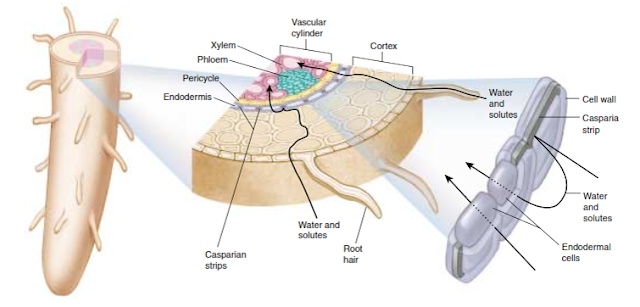b. Among the mehanisms of the translocation of sugar through sieve tubes are the mass-flow
hypothesis, the electro-osmosis ans the cytplasmic streaming. Describe these three
mechanisms. [7]
Answer:
a. - water is absosrbed mainly by root hairs which are cellular extensions of root hair cells.
- the root hairs increase the surface area of the roots enormously.
- dissolved substances build up in root hair cells by diffusion and active transport.
- this accumulation of solutes gives the root hair cells a lower water potential than that of the
water in the soil.
- as a result, water enters a root hair cell by osmosis, increasing its water potential above that of
its neighbours.
- water is then drawn in by osmosis from root hair into the adjacent cortical cells. water moves
from cell to cell in the root along the water potential gradient.
- there are three possible routes:
i. Apoplast pathway
- water passes freely through the cell walls from one cell to another as water is pulled up the
xylem due to transpirational pull, the cohesive forces between water molecules ensure that
water is drawn across adjacent cell walls.
ii. Symplast pathway
- water diffuese through the cytoplasm of adjacent cells
- the cytoplasm of adjacent cells os interconnected by cytoplasmic strands called
plasmodesmata which pass through pores in the cell walls.
iii. Vacuolar pathway
- water moves along through the vacuoles as well as the cytoplasm
- water has to move across the endodermis by the symplast pathway because the cell walls of
the endodermis are impregnated with a waterproof waxy material called suberin called
Casperian strip. the Casperian strip blocks the water passing along the cell walls (apoplast
pathway)
- the endodermal cells actively secrete mineral salts into the xylem vessels of the root. This
lowers the water potential in the xylem vessels. water from the root cells is drawn into the
xylem by osmosis.
b. Mass-flow hypothesis
- the sucrose and other organic solutes synthesized in the leaf are actively loaded by transfer cells and companion cells into the sieve tube.
-this lowers the water potential of the solution in the sieve tubes
- as a result, water is drawn from the xylem in the leaf into the sieve tubes by osmosis.
- the entry of water produces a high hydrostatic pressure in the sieve tube.
- in the roots, the sucrose is actively transported into the tissues for respiration, the synthesis of cell walls or changed into starch for storage.
- the water potential in the root cells decreases. Water is drawn from the sieve tube into the root cells by osmosis
- the hydrostatic pressure in the leaf is higher in the source compared to the pressure in the roots
- this causes passive mass flow of water and solutes such as sugars, amino acids from the leaf to the roots.
Electro-osmosis mechanism (* picture refer to notes)
- the companion cells contain numerous mitochondria which generate ATP required to remove potassium ions from one side of the sieve plate into the companion cell
- the potassium ions are then secreted on the other side of the sieve plate, creating a potential gradient across the sieve plate
- this causes ab electro-osmosis flow of water molecules and dissolved solutes through the sieve pores to the adjacent sieve tube element.
Cytoplasmic streaming mechanism (* picture refer to notes)
- involves a circular movement of cytoplasm from one end of the sieve tube element to the other end.
- the solutes pass through the sieve pores by active transport
-this helps to account for the bidirectional movements along the sieve tubes



